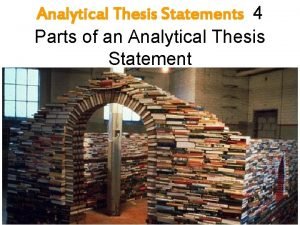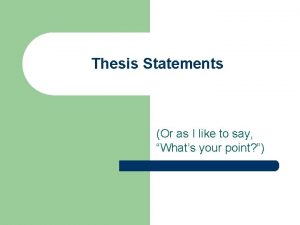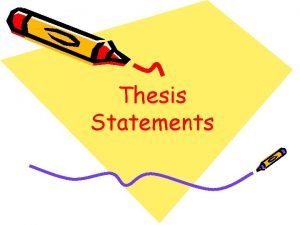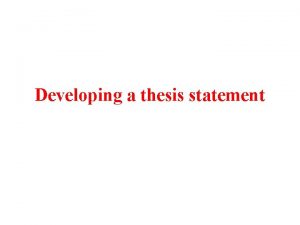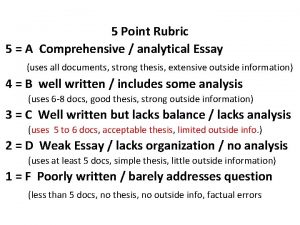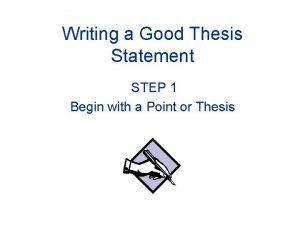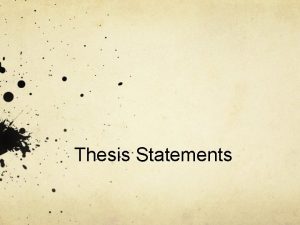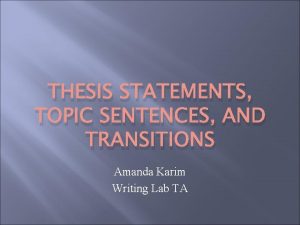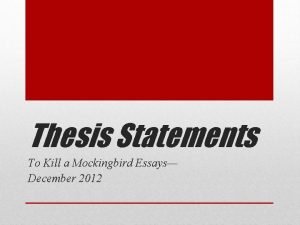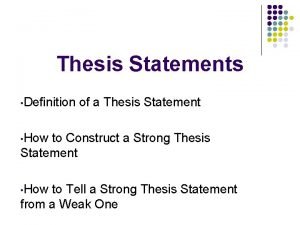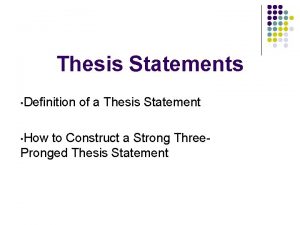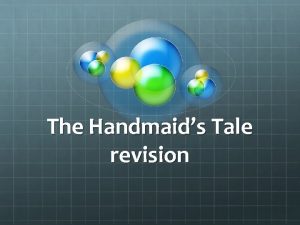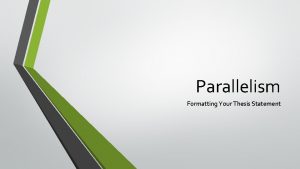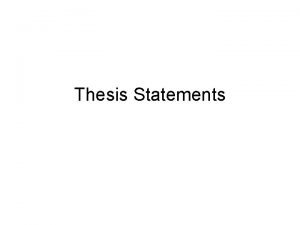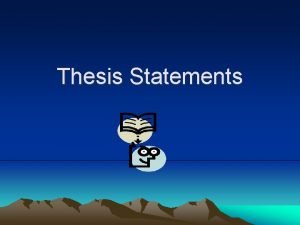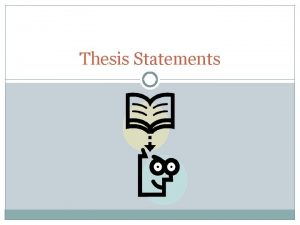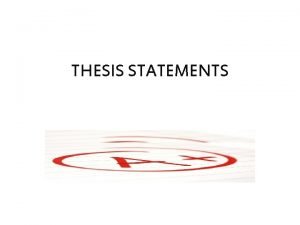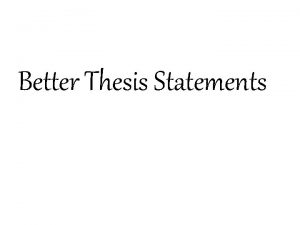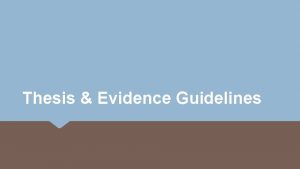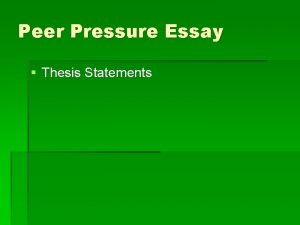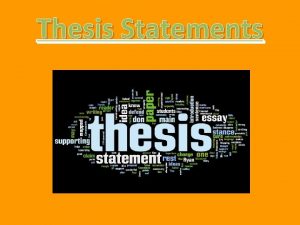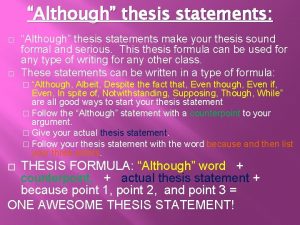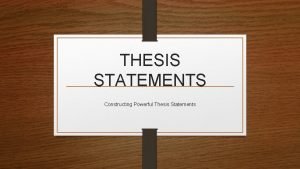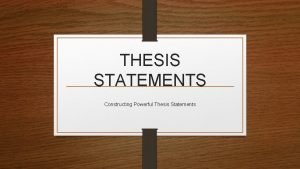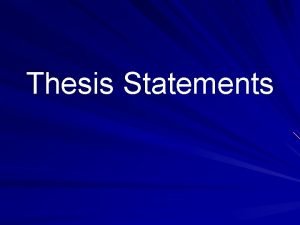Analytical Thesis Statements 4 Parts of an Analytical













- Slides: 13

Analytical Thesis Statements 4 Parts of an Analytical Thesis Statement pics

PART 1 • You must state the topic you are making an argument about. • A topic in a literary rhetorical analysis is the text to which you are responding, the type of text to which you are responding (genre), your focus of the analysis, AND the text’s author. Be as specific as possible! In the short story, “Girl, ” Jamaica Kincaid, the story’s narrator…

PART 2 • THE CLAIM: in the same sentence, you must argue what you believe the author is doing in the text to create the central universal idea you are arguing the text is communicating. • The claim is always a verb, and it should preferably be active.

Analytical “Claim” Verbs – Here are SOME Analytical Verbs: Advocates Alludes to Articulates Argues Asserts Balances Builds Bolsters Catalogs Categorizes Characterizes Clarifies Classifies Collates Compares Concludes Confirms Continues Contrasts Conveys Correlates to Creates Critiques Debates Defends Depicts Details Develops Differentiates Elevates Elicits Emphasizes Employs Establishes Expands Expresses Facilitates Frames Gathers Generates Guides Highlights Identifies Illustrates Implements Implies Imposes Informs Integrates Lectures Moves Perpetuates Persuades Portrays Preaches Presents Promotes Propels Proposes Provoke Raises Recalls Reduces Relates Reinforces Represents Responds Reveals Revitalizes Shows States Strengthens Substantiates Suggests Supports Underlines Validates Verifies

Thesis with the claim… In the short story, “Girl, ” by Jamaica Kincaid, the story’s narrator lectures her daughter … “lectures” is the claim.

PART 3 • Then, in the same sentence, you must back-up your claim with AT LEAST THREE (3) literary devices and/or techniques (aka. DIRECTIONS) that you argue significantly affect the development AND conveyance of the abstract meaning of the passage. • These supporting “DIRECTIONS” are rhetorical or literary devices/techniques that you can demonstrate have a significant effect on the development and conveyance of the text’s abstract universal idea. • By stating three ways in which you will support your argument, you are providing your reader a DIRECTION your reader will follow to reach your paper’s conclusion.

PART 3 Cont… • ALWAYS PREFACE EACH DIRECTION WITH AN analytical ADJECTIVE that concisely conveys the effect of the technique/device identified by thesis direction. . EX: pointed diction unconventional syntax an overall scathing tone

PART 3 Cont… - Thesis statement with the 3 DIRECTIONS: In the short story, “Girl, ” by Jamaica Kincaid, the story’s narrator lectures her daughter with (1) pointed diction and (2) unconventional syntax, both of which affect the development of (3) an overall scathing tone, …

PART 4 • IN THE SAME SENTENCE, you must connect the (1) topic, (2) your claim, and (3) your direction to a theme (aka. The universal idea) • Theme/Universal Idea represents an abstract idea. You need to express this abstract – and oftentimes complex – idea as concisely and succinctly as possible (in as few words as possible).

PART 4 cont… Abstract ideas include: – – Freedom Liberty Justice The pursuit of happiness Abstract means it cannot be touched; it’s an idea. The concrete, things that can be touched, such as symbols and metaphors of all types are used to express the abstract – “the concrete reveals the abstract. ” This is why annotations are so important! They help reveal concrete things that, in context, represent abstract ideas!

PART 4 cont… In the short story, “Girl, ” by Jamaica Kincaid, the story’s narrator lectures her daughter with pointed diction and unconventional syntax, both of which affect the development of an overall scathing tone, that the daughter’s current perceived behavior will lead to a life of promiscuity that will undermine her future respectability and standing within the community. The theme/universal idea = that the daughter’s current behavior, if continued, will lead to a life of promiscuity that will undermine her future respectability and standing within the community.

The Official Analytical Thesis Statement Answering… Examine the tone and theme of Jamaica Kincaid's, "Girl" and discuss how tone and theme was developed through the inventive use of diction, syntax, and specific detail. In the short story, “Girl, ” by Jamaica Kincaid, the story’s narrator lectures her daughter with pointed diction and unconventional syntax, both of which affect the development of an overall scathing tone, that the daughter’s perceived behavior will lead to a life of promiscuity that will undermine her future respectability and standing within the community.

Parts of an Analytical Thesis Statement: 1. State the topic being addressed 2. Your argumentative claim (analytical verb) 3. Direction WITH ADJECTIVES (_______, and ______) (literary devices that affect the development of theme/universal idea) 4. Theme/Universal Idea This Type of Thesis Answers these 2 Questions – What is theme of the piece? – How do you know?
 Analytical thesis statement
Analytical thesis statement Analytical thesis statement
Analytical thesis statement Thesis statements meaning
Thesis statements meaning Theme statement
Theme statement Comprehensive and analytical essay
Comprehensive and analytical essay Thesis statement with reason
Thesis statement with reason Thesis statements for things fall apart
Thesis statements for things fall apart Thesis statements
Thesis statements Transition thesis statements
Transition thesis statements What is a good thesis statement for to kill a mockingbird
What is a good thesis statement for to kill a mockingbird Pronged thesis
Pronged thesis 3 prong thesis statement
3 prong thesis statement Handmaid's tale thesis statements
Handmaid's tale thesis statements Thesis statement parallel structure
Thesis statement parallel structure
